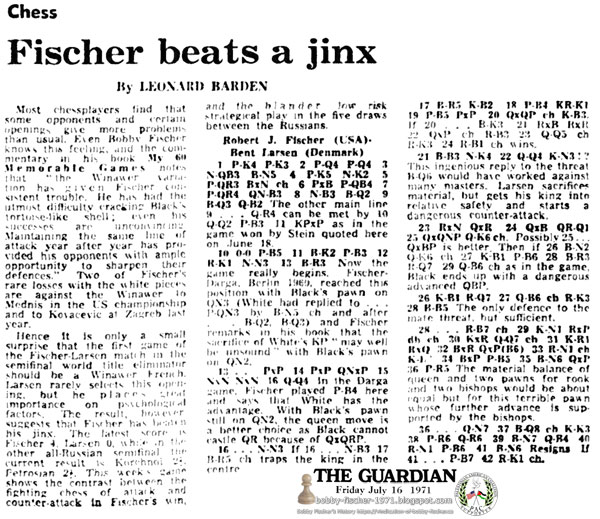The Guardian London, Greater London, England Friday, July 16, 1971 - Page 7
Chess - Fischer Beats a Jinx by Leonard Barden
Most chess players find that some opponents and certain openings give more problems than usual. Even Bobby Fischer knows this feeling, and the commentary in his book My 60 Memorable Games notes that “the Winawer variation has given Fischer consistent trouble. He has had the utmost difficulty cracking Black's tortoise-like shell; even his successes are unconvincing. Maintaining the same line of attack year after year has provided his opponents with ample opportunity to sharpen their defenses.” Two of Fischer's rare losses with the white pieces are against the Winawer to Mednis in the U.S. championship and to Kovacevic at Zagreb last year.
Hence it is only a small surprise that the first game of the Fischer-Larsen match in the semifinal world title eliminator should be a Winawer French. Larsen rarely selects this opening, but he places great importance on psychological factors. The result, however suggests that Fischer has beaten his jinx. The latest score is Fischer 4, Larsen 0, while in the other all-Russian semifinal the current result is Korchnoi 2½, Petrosian 2½. This week's game shows the contrast between the fighting chess of attack and counter-attack in Fischer's win, and the blander low-risk strategical play in the five draws between the Russians.
Robert J. Fischer (USA) vs. Bent Larsen (Denmark)
9. ... Qc7 (The other main line 9. ...Q-R4 can be met by 10 Q-Q2 P-B3; 11. KPxP as in the game won by Stein quoted here on June 18.)
13. Ba3 (Now the game really begins. Fischer-Darga, Berlin 1969, reached this position with Black's pawn on QN3 [White had replied to ... P-QN3 by B-N5ch and after ... B-Q2, B-Q3] and Fischer remarks in his book that the sacrifice of White's KP “may well be unsound” with Black's pawn on QN2.)
16. Qd4 (In the Darga game, Fischer played P-B4 here and says that White has the advantage. With Black's pawn still on Q-N2, the queen move is a better choice as Black cannot castle QR because of QxQRP.)
16. ...Ng6 (If 16. ... N-B3; 17. B-R5 ch traps the king in the centre.)
20. Qxd5+ Kf6 (If 20. ... B-K3; 21. RxB RxR; 22. QxP ch R-B3; 23. Q-Q3ch R-K3; 24. R-B1ch wins.)
22. Qd4 Kg6!? (This ingenious reply to the threat B-Q6 would have worked against many masters. Larsen sacrifices material, but gets his king into relative safety and starts a dangerous counter-attack.)
25. Qxb7 Qe3+ (Possibly 25. ... QxBP is better. Then if 26. B-N2 Q-K6ch; 27. K-B1 P-B6; 28. B-R3 R-Q7; 29. Q-B6ch as in the game, Black ends up with a dangerous advanced QBP.)
28. Bc5 (The only defence to the mate threat, but sufficient.)
36. a5 (The material balance of queen and two pawns for rook and two bishops would be about equal but for this terrible pawn whose further advance is supported by the bishops.)
Robert James Fischer vs Bent Larsen
Fischer - Larsen Candidates Semifinal (1971), Denver, CO USA, rd 1, Jul-06
French Defense: Winawer. Advance Variation (C19) 1-0
https://www.chessgames.com/perl/chessgame?gid=1044346
The Guardian London, Greater London, England Friday, July 16, 1971 Chess by Leonard Barden. No. 1149. White mates in...
Posted by Bobby Fischer's True History on Monday, June 29, 2020
Chess by Leonard Barden. No. 1149. White mates in three moves against any defence (by H. Gartner). This week's problem is more difficult than appears likely from the miniature setting.
FEN 8/r1P4B/1QP5/8/8/8/8/2k3K1 w - - 0 1
1. K-B1 (threat 2. Q-N1ch and 3. Q-K1 mate). If 1. ... K-Q7; 2. Q-N2ch; K-K6 (K-Q8; 3. Q-QB2). 3. Q-KB2. If 1. ... R-QN2; 2. Q-B2 (threat 3. Q-QB2) R-N7; 3. Q-K1 mate.
i.e., 1. Kf1 Kd2 2. Qb2+ Ke3 3. Qf2#























